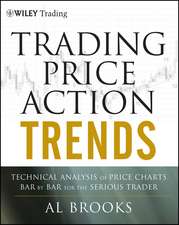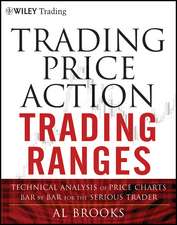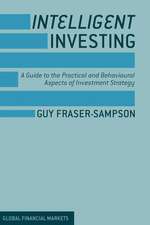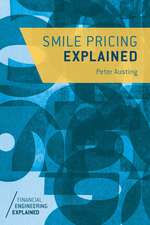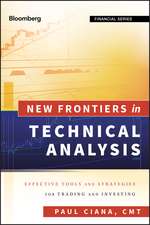Hybrid Securities: Structuring, Pricing and Risk Assessment
Autor Kamil Liberadzki, Marcin Liberadzkien Limba Engleză Hardback – 2 mar 2016
Preț: 640.55 lei
Preț vechi: 753.60 lei
-15% Nou
Puncte Express: 961
Preț estimativ în valută:
122.61€ • 133.22$ • 103.06£
122.61€ • 133.22$ • 103.06£
Carte tipărită la comandă
Livrare economică 21 aprilie-05 mai
Preluare comenzi: 021 569.72.76
Specificații
ISBN-13: 9781137589705
ISBN-10: 1137589701
Pagini: 224
Ilustrații: XII, 224 p.
Dimensiuni: 140 x 216 x 14 mm
Greutate: 0.42 kg
Ediția:1st ed. 2016
Editura: Palgrave Macmillan UK
Colecția Palgrave Macmillan
Locul publicării:London, United Kingdom
ISBN-10: 1137589701
Pagini: 224
Ilustrații: XII, 224 p.
Dimensiuni: 140 x 216 x 14 mm
Greutate: 0.42 kg
Ediția:1st ed. 2016
Editura: Palgrave Macmillan UK
Colecția Palgrave Macmillan
Locul publicării:London, United Kingdom
Cuprins
PREFACE
1.THE DEFINITION OF HYBRID SECURITIES9
1.1. Introduction
1.2. Core features of hybrids
2.EVOLUTION OF HYBRIDS
2.1.Preferred shares
2.2.Perpetual bonds
2.3.Subordinated bonds
2.4.Convertible bonds
2.5.Reverse convertible bonds
2.6.Mandatory convertible bonds
2.7.Catastrophe (CAT) Bonds and Catastrophe Mortality (CATM) Bonds
2.8.Basel I and Basel II capital instruments
2.9.Solvency I capital instruments
2.10.Basel III capital instruments
2.11.Bail-in bonds
2.12Comparison of different conversion into equity mechanisms
2.13 Conclusions
3.LEGAL FRAMEWORK FOR FINANCIAL HYBRIDS IN THE BANKING INDUSTRY
3.1. Transposition of Basel III
3.2.Bank Resolution and Recovery Directive
3.3.Banking Union framework
4.CRD IV/CRR PACKAGE LEGAL FRAMEWORK
4.1.Overview
4.2.Common Equity Tier 1 financial instruments
4.3.Deduction mechanism
5.CRR ADDITIONAL TIER 1 FINANCIAL INSTRUMENTS
5.1.General remarks
5.2.Maturity
5.3.Deferral
5.4.Subordination
5.5.Contingent conversion and write-down
6.CRR TIER 2 BONDS
6.1.General remarks
6.2.Maturity
6.3.Regulatory amortization of T2 financial instruments
6.4.Deferral
6.5.Subordination
6.6.Contingent conversion (write-down)
7.THE ROLE OF HYBRID SECURITIES IN THE BRRD
7.1.Overview
7.2.Early intervention measures7.3.Resolution
7.4.Bail-in tool
8.HYBRID SECURITIES ISSUED BY INSURERS
8.1.General remarks
8.2.Tier 1 hybrid securities
8.3.Tier 2 and Tier 3 hybrid securities
9.CORPORATE HYBRIDS
9.1.Characteristics of corporate hybrids
9.2.Monetizing treasury shares of MOL through issue of perpetual exchangeable bonds via magnolia finance ltd ('Transaction')
10.ISSUANCE OF HYBRIDS
11.PUBLIC OFFERING AND ADMISSION TO TRADING
11.1.Overview
11.2.Scope of the Prospectus Directive
11.3.Financial hybrids as 'non-equity securities'
11.4.Obligation to publish a prospectus
11.5.Stand-alone issue vs. debt programme
11.6.Responsibility attached to prospectus
11.7.Disclosure requirements
12.REGULAR AND TIMELY ONGOING DISCLOSURE86
12.1.Overview
12.2.Transparency Directive
13.FINANCIAL INTERMEDIATION
13.1.Overview
13.2.MiFID
13.3.MiFID II/MiFIR
14. NON-EEA COCOS
14.1. Overview
14.2 Switzerland
14.3. The United States
14.4. BRASIL
14.5.CHINA
14.6.BASEL III-COMPLIANT SUKUK
15.BONDS CREDIT RISK MODELING
15.1 Introduction
15.2 Bond pricing – stochastic approach
15.3 Credit spreads
15.4 The probability of default
16.CONTINGENT CONVERTIBLE BONDS PRICING
16.1. Introduction
16.2. Assets dynamics modeling
16.3. CoCo pricing with a binomial model
16.4. Credit derivatives method
16.5.Equity derivatives method
16.6.The Deutsche Bank CoCos pricing – a case study
17.STRUCTURAL MODEL FOR CORPORATE HYBRID VALUATION
17.1. The model
17.2. Last maturity case
17.3. Valuation of deferrable coupons
Appendix
18.HYBRID SECURITIES' IMPACT ON RISK
18.1 Overview
18.2. Impact of new CoCos on issuer's solvability
18.3. Introduction to market contagion
18.4.Market contagion – definitions
18.5.A framework for market contagion modeling
18.6.Contagion at the bond market
REFERENCES
1.THE DEFINITION OF HYBRID SECURITIES9
1.1. Introduction
1.2. Core features of hybrids
2.EVOLUTION OF HYBRIDS
2.1.Preferred shares
2.2.Perpetual bonds
2.3.Subordinated bonds
2.4.Convertible bonds
2.5.Reverse convertible bonds
2.6.Mandatory convertible bonds
2.7.Catastrophe (CAT) Bonds and Catastrophe Mortality (CATM) Bonds
2.8.Basel I and Basel II capital instruments
2.9.Solvency I capital instruments
2.10.Basel III capital instruments
2.11.Bail-in bonds
2.12Comparison of different conversion into equity mechanisms
2.13 Conclusions
3.LEGAL FRAMEWORK FOR FINANCIAL HYBRIDS IN THE BANKING INDUSTRY
3.1. Transposition of Basel III
3.2.Bank Resolution and Recovery Directive
3.3.Banking Union framework
4.CRD IV/CRR PACKAGE LEGAL FRAMEWORK
4.1.Overview
4.2.Common Equity Tier 1 financial instruments
4.3.Deduction mechanism
5.CRR ADDITIONAL TIER 1 FINANCIAL INSTRUMENTS
5.1.General remarks
5.2.Maturity
5.3.Deferral
5.4.Subordination
5.5.Contingent conversion and write-down
6.CRR TIER 2 BONDS
6.1.General remarks
6.2.Maturity
6.3.Regulatory amortization of T2 financial instruments
6.4.Deferral
6.5.Subordination
6.6.Contingent conversion (write-down)
7.THE ROLE OF HYBRID SECURITIES IN THE BRRD
7.1.Overview
7.2.Early intervention measures7.3.Resolution
7.4.Bail-in tool
8.HYBRID SECURITIES ISSUED BY INSURERS
8.1.General remarks
8.2.Tier 1 hybrid securities
8.3.Tier 2 and Tier 3 hybrid securities
9.CORPORATE HYBRIDS
9.1.Characteristics of corporate hybrids
9.2.Monetizing treasury shares of MOL through issue of perpetual exchangeable bonds via magnolia finance ltd ('Transaction')
10.ISSUANCE OF HYBRIDS
11.PUBLIC OFFERING AND ADMISSION TO TRADING
11.1.Overview
11.2.Scope of the Prospectus Directive
11.3.Financial hybrids as 'non-equity securities'
11.4.Obligation to publish a prospectus
11.5.Stand-alone issue vs. debt programme
11.6.Responsibility attached to prospectus
11.7.Disclosure requirements
12.REGULAR AND TIMELY ONGOING DISCLOSURE86
12.1.Overview
12.2.Transparency Directive
13.FINANCIAL INTERMEDIATION
13.1.Overview
13.2.MiFID
13.3.MiFID II/MiFIR
14. NON-EEA COCOS
14.1. Overview
14.2 Switzerland
14.3. The United States
14.4. BRASIL
14.5.CHINA
14.6.BASEL III-COMPLIANT SUKUK
15.BONDS CREDIT RISK MODELING
15.1 Introduction
15.2 Bond pricing – stochastic approach
15.3 Credit spreads
15.4 The probability of default
16.CONTINGENT CONVERTIBLE BONDS PRICING
16.1. Introduction
16.2. Assets dynamics modeling
16.3. CoCo pricing with a binomial model
16.4. Credit derivatives method
16.5.Equity derivatives method
16.6.The Deutsche Bank CoCos pricing – a case study
17.STRUCTURAL MODEL FOR CORPORATE HYBRID VALUATION
17.1. The model
17.2. Last maturity case
17.3. Valuation of deferrable coupons
Appendix
18.HYBRID SECURITIES' IMPACT ON RISK
18.1 Overview
18.2. Impact of new CoCos on issuer's solvability
18.3. Introduction to market contagion
18.4.Market contagion – definitions
18.5.A framework for market contagion modeling
18.6.Contagion at the bond market
REFERENCES
Notă biografică
Dr Marcin Liberadzki is a Senior Lecturer at the Warsaw School of Economics, Department of Finance. He holds master's degrees in Finance and Banking (from the WSE), and in Law (the University of Warsaw, Faculty of Law), as well as PhD in Economic Science from the Warsaw School of Economics. He conducts research on convertible bonds, credit derivatives, sub-prime crisis, project finance and public-private partnership in the financing of infrastructure. After passing the Law Society examinations Marcin has been made a legal adviser and advocate. He runs his own law firm in Warsaw, Poland. He is author and co-author of over 30 scientific articles and 3 books.
Dr Kamil Liberadzki was awarded a PhD in Finance from the Department of Banking, the Warsaw School of Economics. He graduated within the Finance and Banking Faculty at the WSE and from the Law Faculty at Warsaw University. He is Senior Lecturer in the Institute of Finance at Warsaw School of Economics and lectures on investment banking, investment portfolio modeling, bonds and hybrid securities and financial mathematics.
His expertise surrounds fixed income securities, including issue structuring, risk management and pricing. He is also a partner at a legal firm delivering expertise to among the largest Polish banks and financial institutions.
Dr Kamil Liberadzki was awarded a PhD in Finance from the Department of Banking, the Warsaw School of Economics. He graduated within the Finance and Banking Faculty at the WSE and from the Law Faculty at Warsaw University. He is Senior Lecturer in the Institute of Finance at Warsaw School of Economics and lectures on investment banking, investment portfolio modeling, bonds and hybrid securities and financial mathematics.
His expertise surrounds fixed income securities, including issue structuring, risk management and pricing. He is also a partner at a legal firm delivering expertise to among the largest Polish banks and financial institutions.
Textul de pe ultima copertă
Hybrid capital securities or 'hybrids' offer various benefits. They offer flexibility equity without shareholder dilution, provide protection to senior creditors, are a stable source of long-term funding for healthy companies, and help insurers and banks meet regulatory and rating agency capital requirements. Risks and features of hybrid securities are expressed in the credit spread of some relatively new financial instruments, but no structural fundamentals exist for to price hybrids precisely.
This book proposes a model for the pricing of hybrids. It begins by explaining the concept of hybrids as well as their equity- and debt-like characteristics. Different types of hybrids are presented, including preference shares, convertible bonds, contingent convertibles (CoCos) and bail-in bonds. The authors then present analysis of regulatory regimes' impact on hybrids. They discuss the types of hybrid bonds that are contemplated in the Capital Requirements Regulation (CRR) and BankingUnion mechanism. They then present an in-depth examination of hybrids pricing and risk assessment techniques. The book provides a comprehensive analysis from mathematical, legal and financial perspectives in order to look at relatively new financial instruments and address problems with the pricing models of hybrids which are as yet unsolved.
This book proposes a model for the pricing of hybrids. It begins by explaining the concept of hybrids as well as their equity- and debt-like characteristics. Different types of hybrids are presented, including preference shares, convertible bonds, contingent convertibles (CoCos) and bail-in bonds. The authors then present analysis of regulatory regimes' impact on hybrids. They discuss the types of hybrid bonds that are contemplated in the Capital Requirements Regulation (CRR) and BankingUnion mechanism. They then present an in-depth examination of hybrids pricing and risk assessment techniques. The book provides a comprehensive analysis from mathematical, legal and financial perspectives in order to look at relatively new financial instruments and address problems with the pricing models of hybrids which are as yet unsolved.



